Welcome to our guide to unique festivals.
There’s traveling — and then there’s traveling. The kind where you wake up in a small Spanish town covered in tomato pulp, or watch monkeys down Fanta on ancient Thai ruins, or find yourself clapping for a guy pretending to play an invisible guitar in subarctic Finland. These are the stories that don’t just fill your passport — they rewrite your definition of what “culture” even means.
This is your insider guide to the ten most unique festivals. The most unforgettable experiences on Earth — where tradition meets absurdity, chaos meets reverence, and travel becomes pure, beautiful madness.
And yes, they’re all real.
Your Guide to The World’s Most Unique Festivals

1. La Tomatina – Buñol, Spain
When: Last Wednesday of August
Best described as: A massive tomato-based street war
Buñol is a sleepy town for 364 days a year. But on one Wednesday in August, it transforms into something out of a vegetable apocalypse movie. Thousands of people — locals, tourists, and the merely curious — flood the narrow streets for one hour of glorious, unbridled chaos. La Tomatina began in 1945 when a group of young pranksters crashed a local parade and started a food fight with nearby vendors. The police broke it up. They tried again the next year. And the next. Eventually, the town gave up and made it official.
Today, over 100 tons of overripe tomatoes are dumped into the square. The cannon sounds. And for one glorious hour, it’s all-out war. It’s messy, cathartic, and surprisingly friendly — the rules are simple: squish before you throw, no hard objects, and stop when the second cannon fires.
Destination Expert Tip:
Stay in Valencia, just 40 minutes away by train. Bring goggles and clothes you’ll never want to see again. And don’t try to “win” — everyone loses. And that’s kind of the point.
Sustainably Speaking:
The tomatoes are low-grade produce unfit for sale, and afterward, the streets are cleaned using water from the nearby river — a rare case of eco-friendly mayhem.
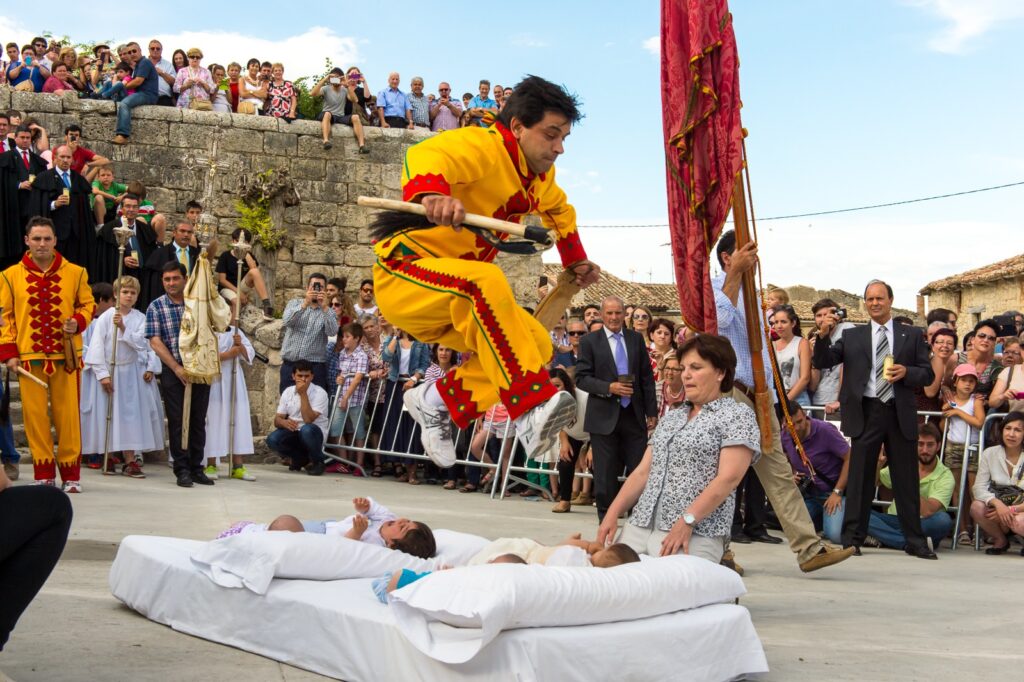
2. Baby Jumping Festival – Castrillo de Murcia, Spain
When: June
Best described as: A demonic hurdle race over newborns
Some festivals celebrate harvests. Some celebrate saints. Castrillo de Murcia celebrates men in devil costumes leaping over babies.
“El Colacho,” as it’s called, dates back to 1620 and represents the triumph of good over evil. The devils, clad in bright yellow suits and grotesque masks, run through the town leaping over rows of infants laid on mattresses — symbolically cleansing them of original sin. It’s absurd, surreal, and weirdly moving. Local priests bless the babies before the jump, and afterward, the families lift their freshly “purified” children to the applause of the crowd.
Local Expert Tip:
Don’t volunteer your own child unless you’re fully committed — it’s a centuries-old tradition but not exactly covered by modern parenting manuals. Spectating is a safer bet, and the town’s post-festival feast is worth the trip alone.
Sustainably Speaking:
The festival is entirely community-run, with local food, crafts, and zero corporate sponsorship — a pure, slow-culture celebration of folklore and faith.
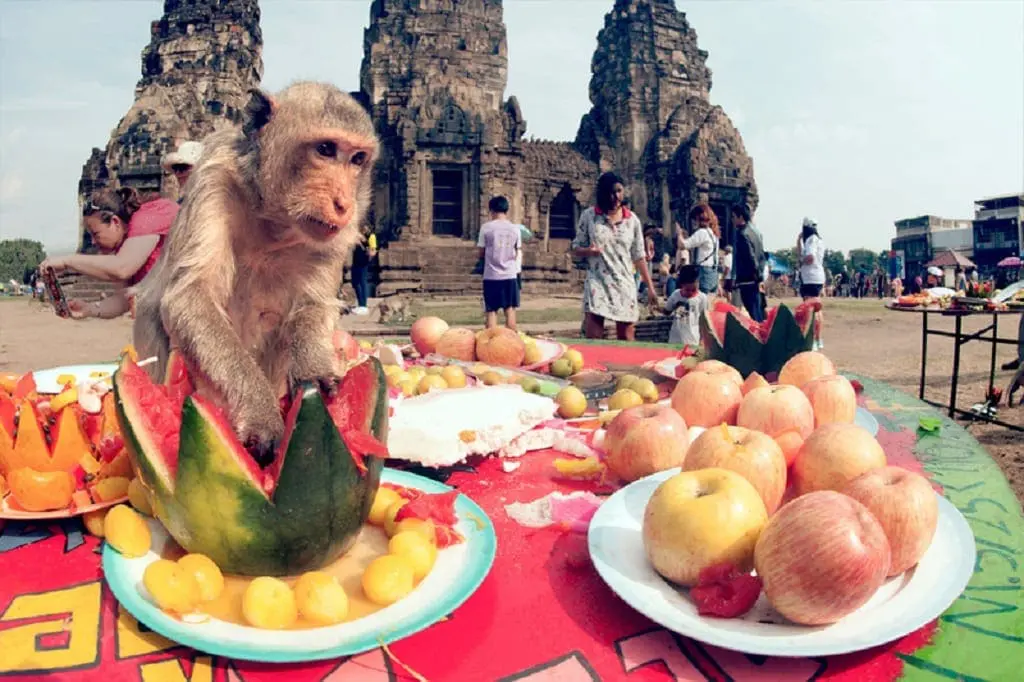
3. The Monkey Buffet Festival – Lopburi, Thailand
When: Last Sunday in November
Best described as: A banquet for monkeys with front-row chaos for humans
Every November, the historic town of Lopburi becomes the site of the world’s most chaotic dinner party. Thousands of macaques — Lopburi’s true locals — are treated to a 4,000-kilogram feast of fruits, vegetables, sweets, and soft drinks. It began in 1989 as a tourism stunt to honor the monkey god Hanuman and thank the local monkeys for bringing prosperity. Today, it’s an annual act of interspecies diplomacy.
The monkeys climb, steal, shriek, and feast while locals laugh and tourists nervously clutch their belongings. It’s a surreal fusion of chaos and reverence that sums up Thailand’s ability to turn even madness into art.
Destination Expert Tip:
Bring sealed bags, no loose jewelry, and an open mind. The monkeys are bold, not malicious — think of it as cultural exchange with a side of chaos.
Sustainably Speaking:
The festival promotes local tourism in an otherwise quiet province and encourages wildlife conservation — even if the wildlife occasionally steals your snacks.
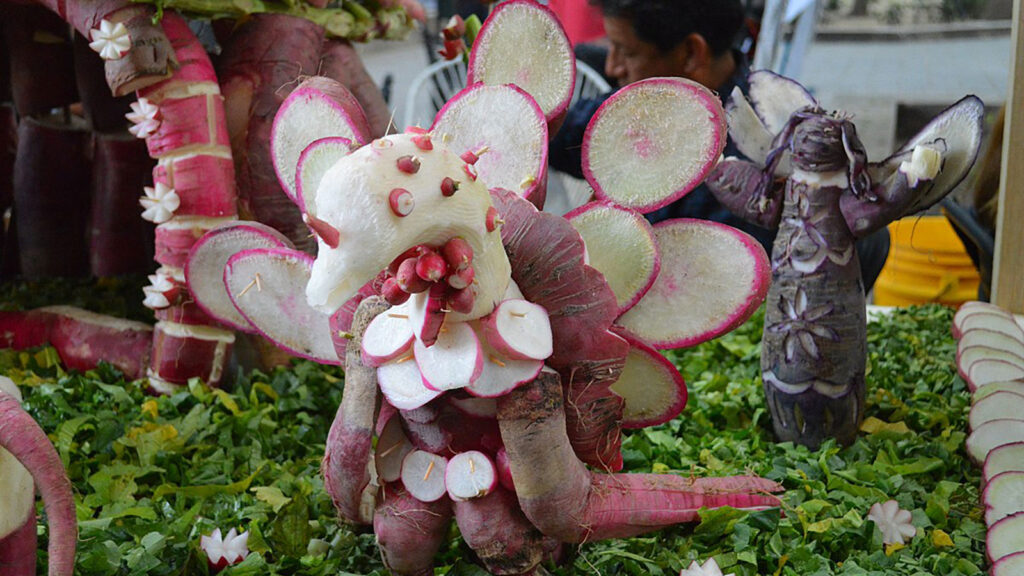
4. The Night of the Radishes – Oaxaca, Mexico
When: December 23
Best described as: Christmas meets vegetable sculpture
If you thought “creative vegans” were a modern invention, Oaxaca has been carving vegetables for centuries. Every December 23, artisans compete in La Noche de Rábanos — the Night of the Radishes — transforming massive, specially grown radishes into elaborate sculptures. We’re talking full nativity scenes, mythical beasts, Day of the Dead skeletons, and political satire, all made from root vegetables.
The festival dates to the colonial era, when farmers carved radishes to attract customers at the Christmas market. Now it’s a national treasure, drawing thousands to the main plaza for a single night before the sculptures wilt at midnight.
Local Expert Tip:
Pair the festival with a food pilgrimage through Oaxaca’s markets — mole negro, tlayudas, and chapulines (grasshoppers) are local musts.
Sustainably Speaking:
The radishes are grown specifically for the festival and composted afterward — a zero-waste celebration of creativity and culture.
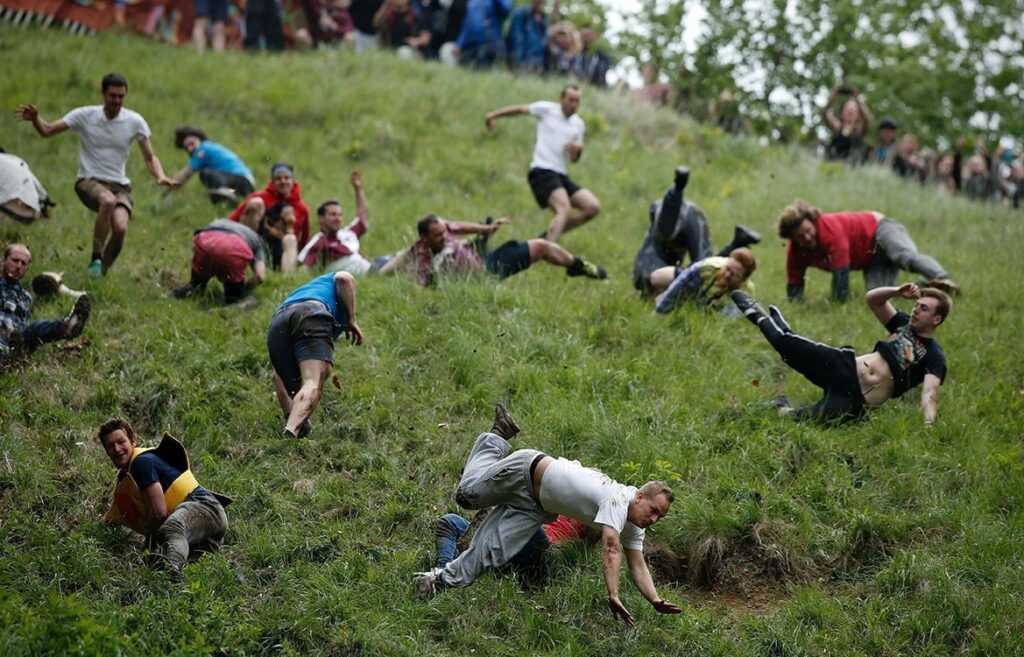
5. Cooper’s Hill Cheese Rolling – Gloucester, England
When: Last Monday of May
Best described as: Chasing dairy at terminal velocity
Only the British could turn a cheese wheel into a national sport. Since the early 1800s, locals in Gloucester have been sprinting down a near-vertical 200-meter hill after a rolling wheel of Double Gloucester cheese. The cheese hits speeds of 70 mph. The competitors hit hospital beds.
The winner? Whoever crosses the finish line first — cheese or no cheese. It’s a bruising, bone-rattling tradition that’s been banned, revived, and loved all the same.
Destination Expert Tip:
Don’t join. Watch. The locals are trained, often from childhood, in the art of controlled tumbling. Afterward, head to one of Gloucester’s cozy pubs and toast the brave (and slightly unhinged) souls who rolled before you.
Sustainably Speaking:
The cheese is made by local farms, and the festival’s revival has boosted community tourism — proof that even chaos can be good for the local economy.

6. Kanamara Matsuri – Kawasaki, Japan
When: April
Best described as: The world’s most joyful fertility parade
Japan’s Festival of the Steel Phallus is as bold as it sounds — a jubilant celebration of fertility, safe sex, and humor. The festival dates to the 1600s, when sex workers prayed to the Kanayama Shrine for protection from disease. The legend says a woman once had her privates inhabited by a demon with teeth — and a blacksmith forged a steel phallus to break the curse.
Now, that steel symbol has become the centerpiece of a parade featuring giant phallic floats, pink lollipops, and laughter that manages to be both cheeky and spiritual.
Destination Expert Tip:
Visit the Kanayama Shrine early for a quieter moment of reflection — the festival might look wild, but its heart is about protection, acceptance, and humor in the face of taboo.
Sustainably Speaking:
Proceeds go to HIV research and sexual health charities — proof that even the world’s weirdest festivals can do good.

7. Air Guitar World Championships – Oulu, Finland
When: August
Best described as: Rock without the strings (or shame)
The philosophy is simple: “Make air, not war.”
Since 1996, the Air Guitar World Championships have turned the small city of Oulu into the epicenter of global rock absurdity. Contestants from around the world compete by performing invisible solos on imaginary guitars. Costumes, jumps, and unrestrained passion are mandatory.
It’s surprisingly emotional. The event began as a joke — now it’s a statement about peace, performance, and the power of pure joy.
Local Expert Tip:
Oulu in summer is stunning — combine the championship with a trip to the midnight sun beaches and local sauna culture. You’ll leave believing that invisible music might just change the world.
Sustainably Speaking:
It’s a zero-waste festival — no instruments, no props, just pure energy and imagination.

8. The Fireball Festival – Nejapa, El Salvador
When: August 31
Best described as: Dodgeball, but flaming
If you thought fire juggling was extreme, try fire dodgeball. The Bolas de Fuego festival in Nejapa commemorates a 1658 volcanic eruption that forced locals to flee their homes. Today, it’s reenacted through friendly street battles with flaming rags soaked in kerosene. Participants wear fireproof gloves and wet rags for protection. The result? An infernal dance of sparks, smoke, and adrenaline — a fierce homage to resilience and rebirth.
Destination Expert Tip:
Don’t join unless you’re trained. Spectators stand safely behind barriers, and local firefighters are always present. The town’s post-festival parties are warm (figuratively this time) and welcoming.
Sustainably Speaking:
The fireballs use minimal fuel, and the festival funds community safety initiatives — turning a destructive past into cultural empowerment.
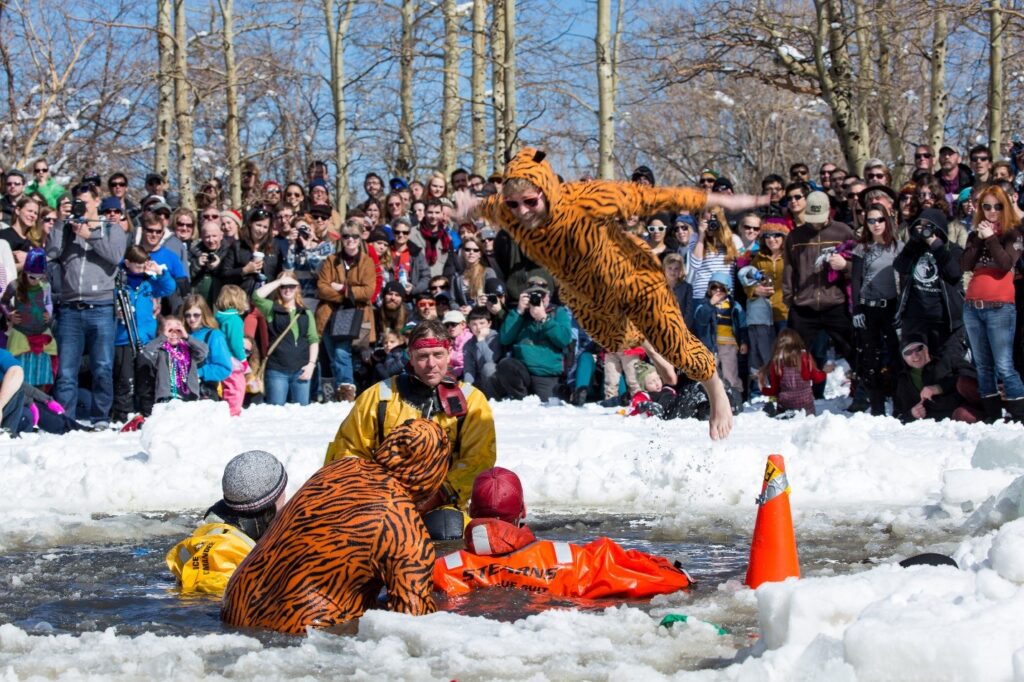
9. Frozen Dead Guy Days – Nederland, Colorado, USA
When: March
Best described as: A cryogenic comedy festival in the Rockies
Here’s one for the cold-hearted.
In the early 1990s, a Norwegian man named Bredo Morstoel was cryogenically frozen by his grandson and stored in a shed in the town of Nederland. When the authorities found out, the locals didn’t shut it down — they threw a party. Frozen Dead Guy Days became an annual celebration of life, death, and absurdity — complete with coffin races, frozen T-shirt contests, and bands with names like “The Cold Shoulders.”
The festival has since migrated across Colorado, but its spirit lives on — a darkly funny reminder that mortality can be met with a wink and a beer.
Destination Expert Tip:
Check current locations (as it occasionally relocates), and book accommodations early — the festival sells out every year.
Sustainably Speaking:
The event funds local nonprofits and environmental programs, proving that even death can contribute to life.
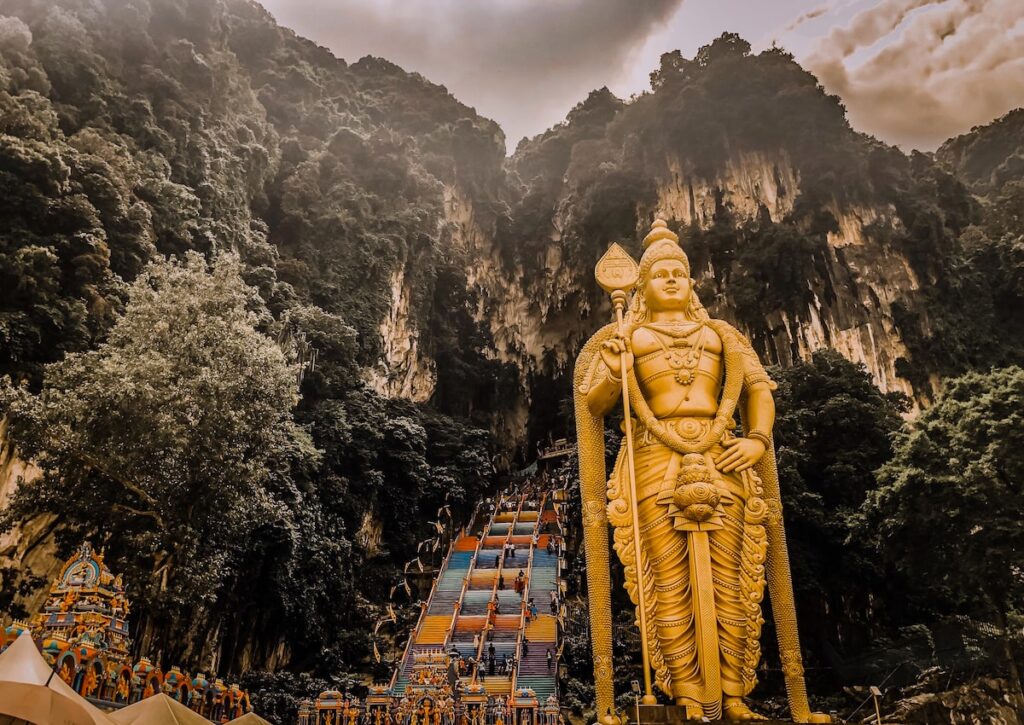
10. Thaipusam – Batu Caves, Malaysia
When: January or February
Best described as: Faith, endurance, and spiritual steel
Among all the world’s strange and powerful festivals, Thaipusam might be the most humbling.
Devotees gather at the Batu Caves near Kuala Lumpur to honor Lord Murugan through intense physical devotion — carrying decorated structures called kavadi, often attached to their bodies with hooks and skewers. The procession climbs 272 steep steps into the limestone caves, accompanied by chanting, drumming, and an atmosphere so charged it feels electric. It’s not a spectacle. It’s sacred — a profound reminder of how belief can transform pain into transcendence.
Local Expert Tip:
Visit respectfully — dress modestly, avoid intrusive photos, and engage with locals to understand the ritual’s spiritual roots.
Sustainably Speaking:
The Batu Caves complex emphasizes eco-preservation and cultural education, balancing tourism with spiritual integrity.
The Beauty of the Bizarre
These festivals remind us that travel isn’t about checking off landmarks — it’s about seeing what happens when humans let creativity, history, and chaos dance together. Whether you’re being pelted with fruit, sculpting radishes, or cheering for invisible rock stars, these experiences connect us to something older and wilder — a global heartbeat of celebration that refuses to be tamed.
So pack your curiosity. Book that ticket to Spain, Japan, or El Salvador. And when someone asks what you did on your trip, you can say, “I watched babies get jumped over by devils” — and mean it. Because in the end, travel isn’t just about where you go. It’s about how deep — and how weird — you’re willing to go once you get there.
Sustainable Travel Tips for Festival Lovers
If you’re planning to chase the world’s strangest festivals, do it right. Here’s how to keep it sustainable and respectful:
1. Travel Slow
Instead of flying in for a weekend, make it part of a longer regional journey. Stay longer, spend locally, and cut your carbon footprint.
2. Eat and Stay Local
Skip global chains. These festivals thrive on small-scale economies — eat street food, book family-run guesthouses, and shop at community markets.
3. Minimize Waste
Bring a reusable bottle, avoid single-use plastics, and respect local waste systems. Many festivals are going green — you should too.
4. Learn Before You Go
Understand the story, not just the spectacle. Every bizarre ritual has deep roots — knowing them makes you a better traveler and a more respectful witness.
5. Participate Respectfully
If you’re joining in, ask locals how. Festivals are invitations, not performances — honor the culture that made them.
Where to Start
If you’re ready to embrace the weird, start with La Tomatina or Frozen Dead Guy Days — playful, accessible, and unforgettable. Then graduate to Thaipusam or El Colacho, where history, faith, and human expression collide.
Every one of these festivals offers a window into what it really means to be human — joyful, strange, and gloriously unfiltered.
So go. Chase cheese. Dance with fire. Throw a tomato. Travel not just for beauty, but for the absurd. Because sometimes, the strangest places are where you find the truest stories.